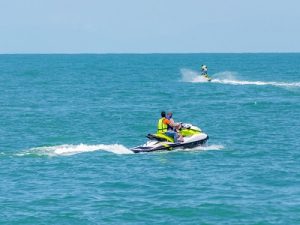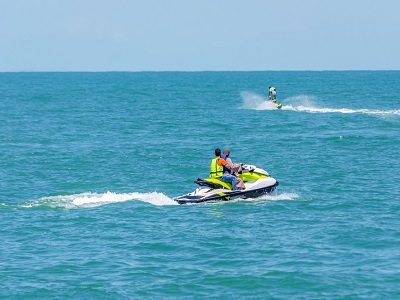 It is possible to use a jet ski during winter. However, you need to be aware of several factors before you get on the water. You’ve come to right place if you want to learn how to ride a jet ski during this season.
It is possible to use a jet ski during winter. However, you need to be aware of several factors before you get on the water. You’ve come to right place if you want to learn how to ride a jet ski during this season.
Is it possible to use your jet ski in winter?
Jet skiing isn’t a common winter sport, let’s face it.
Hardcore riders, despite this fact, often can’t wait to take their skis for a spin in the spring, even though that’s is the coldest months of the year.
You don’t have to deal with the hassle of boat traffic so you can enjoy a great riding experience. You don’t have to wait long at the boat ramp for “the show”.
As you can see, winter jet skiing is not without dangers.
Jet skis can still be used in winter, but this depends on where you live. Contrary to popular belief, air temperature isn’t the only thing that should be considered before you take off on a winter jet ski trip.
These are the main factors that you need to consider:
- Air temperature
- Water conditions and temperature
- Other weather conditions include wind, rain and fog
- Your ski’s type and features
- Conditions for storage of your ski
Let’s get into the details, and discuss each one in detail!
Is it too cold to jet ski?
Temperature of the Air
The jet skiing season usually lasts from spring to Labor Day. This means that most riders can no longer jet ski once the September cold wave has passed. Hardcore riders will take to the water at temperatures as low as 40 to 45 degrees F. While “too cold” can mean something different to each person, the general consensus is that it’s not recommended to use a jet ski rental when the temperatures are below 32degrees Fahrenheit.
Why?
This is because, when the temperature drops below freezing, ice can form in the cooling line’s intake. Overheating can be caused by this buildup.
The front of the ski can also become iced up, making it difficult to open the storage.
Water Temperature and Conditions
Water conditions are just as important as the temperature of the air. Temperature can make it dangerous to ride in cold water.
The greatest danger of winter jet ski rides involves falling in the water. Even if you are wearing a quality wetsuit, this can cause you to get very cold quickly.
Your internal temperature drops significantly after being submerged into cold water. If it is lucky, your internal body temperature returns to normal. However, in the worst cases, you may suffer from hypothermia.
Other Weather Conditions
You should avoid riding your jet ski in the winter because of the above risks.
You will always face more water spray and flooded feetwells in rough waters. You also have to be aware of the fact that you are more likely to fall into the water than normal.
Jet ski rides can be dangerous because of fog or mist.
Keep safety in mind and don’t forget to check the weather conditions before you go. Also, keep an eye on weather changes during your ride.
You should also not ride alone, as you never know if you’ll need help.
Your Jet Ski’s Features
Is it bad for jet ski rental in Myrtle Beach to be in cold water? This is a common question that many riders ask. The answer is that it depends. The intake of the closed-loop cooling system can become ice at temperatures below freezing. This can lead to engine overheating.
Riders are concerned that external water may be too cold, which could lead to low engine temperatures. This concern is partially justified.
Modern 4-stroke jet skis are equipped with a thermostat to regulate the temperature of their cooling system.
The system can maintain a healthy engine temperature, regardless of external water temperatures. These skis perform better in cold or dry conditions than they do in warm or moist environments.
However, older 2-stroke jet skis do not have this thermostat. Therefore, cold water can negatively impact their performance and engines, but not always.
Before you go on the water, ensure that your ski’s cooling system is working properly. The cooling system can become blocked if there is too much ice.
Keep an eye on the temperature of your jet ski in Myrtle Beach. You should return to the dock if you feel that its controls are freezing or if you notice any other problems.
Storage Conditions for Your Jet Ski
Remember to winterize your jet skis after each season. To avoid damage to your skis, you should winterize them again after each ride. What should you wear on a Jet Ski in Winter?
The best winter jet ski clothing can be found here:
- Life jacket
- Wetsuits or drysuits with sweats
- Boots/Shoes/Neoprene shocks
- Neoprene jacket/spray jacket
- Hand warmers/guards
- Gloves with latex gloves under
- Helmet/hat/mask/balaclava
- Earplugs
- Goggles
- Wetsuits and Drysuits
A decent wetsuit and drysuit are essential for winter jet ski rides.
A thick wetsuit can keep you warmer than a regular drysuit on windy days, but this is a less-known fact. Wetsuits can be more difficult to get into and out of.
It is a rule of thumb that the thicker the suit, the greater its protection and flexibility.
However, wetsuits don’t keep your body dry. It allows for a thin layer of water to be placed between the suit and the body, which acts as thermal insulation.
To keep your body warm, wear underneath clothing if you are wearing a dry suit. Drysuits don’t allow for air circulation. Drysuits can quickly become sweaty if you are wearing them.
Call Action Water Sportz now if you are looking for a jet ski rental in Myrtle Beach.
Like our Facebook page for more great info about jet skis.
Action Water Sportz
1525 13th Ave N
North Myrtle Beach, SC 29582
(843) 280-4100
http://www.actionwatersportz.com/
Action Water Sportz Little River
4430 Kingsport Road
Little River SC 29566
843-280-3100

